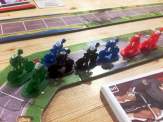| Release Date: 2023 | Players: 2-6 |
| Designer: Gary Kim, Hope S. Hwang, Yohan Goh | Length: 15-30 minutes |
| Artist: Crocotame | Age: 8+ |
| Publisher: Helvetiq | Complexity: 1.5 / 5 |
| Plastic (by weight): <1% | Air (by volume): <1% |
Viking warriors cherish war. They bravely man their longships with healers, skalds, spies, seidmadrs, völva, hirdmen, berserker, a styrimader and maybe even the jarl. They go on long voyages to conquer far-away lands and fight the locals in glorious battles. Those Vikings who fall go to Valhalla, a majestic hall located in Asgard and presided over by the god of gods, Odin by Yohan Goh, Hope S. Hwang and Gary Kim from Helvetiq.
Listen to the Audio Version
Intro Music: Bomber (Sting) by Riot (https://www.
The Vikings by Alexander Nakarada (CreatorChords) | https://creatorchords.com
Music promoted by https://www.free-stock-music.com
Creative Commons / Attribution 4.0 International (CC BY 4.0)
https://creativecommons.org/licenses/by/4.0/
Viking Intro (Loop) by Alexander Nakarada (CreatorChords) | https://creatorchords.com
Music promoted by https://www.free-stock-music.com
Creative Commons / Attribution 4.0 International (CC BY 4.0)
https://creativecommons.org/licenses/by/4.0/
Of course, this setting is potentially rather tenuous, because Odin is a rather abstract ladder-climbing card game. However, as the rulebook explains, the publisher wanted to give the game a theme. So because the prototype was called Valhalla and already had a Viking theme, they stuck with it.
I must say, it does work and means that the cards have beautifully illustrated Vikings adorning their fronts. Crocotame‘s simplified art style is really fitting for what is a game that can be played by players from a wide range of ages. Add to that the fact that Odin works for two to six players, has very little rules overhead and a short playing time and you end up with a great family game – but let me substantiate my claim.
Climbing to Valhalla
The rules fit on a single sheet and take about 10 minutes to explain, probably less. Setup is even quicker: shuffle all the cards and deal nine to each player. Within 15 minutes you’re ready to play your first game.
Playing time is also really quick. The game consists of a number of rounds and you play until someone reaches a certain score. Your first game is recommended to end at 15 points, but you can increase or decrease that number to make the game last longer or be quicker.
During each round, you play a single or a set of cards whose total value is higher than the current highest bid. If you can’t or don’t want to play a higher set, you pass, but if the game comes back round to you, you can play on your next turn or pass again. So you’re not completely out when you pass. When you do play cards, they all have to be the same colour, out of the six available, or the same number.
As soon as someone has emptied their hand, the round ends. Now everyone scores the cards in their hand and adds them to their running totals. If someone has reached the target points decided at the beginning, the game ends and the player with the lowest score wins. Otherwise, you play another round.
There are a few more rules that I haven’t mentioned, but that’s the principle. It’s all really easy. You want to be the first to empty your hand and overall have the fewest points.

Scouting Odin
Odin reminds me a lot of Scout, which is no surprise of course. Both are so-called ladder-climbing games, where players play more and more valuable sets of cards. However, the similarities don’t end there. Both games require players to make a lot of important, if small, decisions and think about their tactics. You have to decide when to pass and when to break up your sets of cards. There is a lot of subtlety in both games that makes them relatively deep, without being too demanding.
Odin is probably a little easier to play, because you can re-arrange your hand at any time, which is not allowed in Scout. However, both work very much in the same way. So if you like one, you will definitely like the other. Which of the two you are going to prefer is a bit harder to decide though.
For me, both games have their rightful place in my collection. If I want to play with younger people or people who are relatively new to modern hobby games, then Odin will be my first choice. Only by a smidge though. Scout is similarly easy to learn, but offers a little bit more of a challenge for those who want it. That implies that Odin is great when you don’t want to have to think too hard. So while both games scratch very similar itches, they both equally deserve a space on my board game shelf and on the table.
So if you already have Scout, I’d say it’s still worth looking at Odin too. Vice versa, if you enjoy Odin, then definitely give Scout a go. Both are small-box games that won’t take much room on your shelf and you can easily fit both into your coat pockets to bring to game night.
Reaching Valhalla
There really isn’t anything else to say. So, in closing, let me ask you to bring out your brave Vikings and lead them to victory. Let them have their moment of glory on the table, before they are swept away by the next band of norsepeople. Keep your nerve and focus on the ultimate goal: for all of you to sit in Valhalla alongside Odin.
Keeping the blog running takes time and resources. So if you can chip in, that would be amazing.
Useful Links
- Odin: https://helvetiq.
com/ intl/ odin - Rulebook: https://helvetiq.
com/ media/ hexaattachment/ products/ attachments/ Odin_ Rules_ EN_ DE_ FR_ ES_ IT_ NL_ compressed. pdf - Helvetiq: https://helvetiq.
com/ intl/ - BGG listing: https://boardgamegeek.
com/ boardgame/ 406854/ odin - Scout review: https://tabletopgamesblog.
com/ 2022/ 07/ 02/ scout-saturday-review/
Videos
Transparency Facts
I feel that this review reflects my own, independent and honest opinion, but the facts below allow you to decide whether you think that I was influenced in any way. Please also read my Ethics Statement for more information.- I bought and paid for the game myself.
- At the time of writing, I have not received financial support from the publisher or anyone working on their behalf.
Audio Version
Intro Music: Bomber (Sting) by Riot (https://www.
The Vikings by Alexander Nakarada (CreatorChords) | https://creatorchords.com
Music promoted by https://www.free-stock-music.com
Creative Commons / Attribution 4.0 International (CC BY 4.0)
https://creativecommons.org/licenses/by/4.0/
Viking Intro (Loop) by Alexander Nakarada (CreatorChords) | https://creatorchords.com
Music promoted by https://www.free-stock-music.com
Creative Commons / Attribution 4.0 International (CC BY 4.0)
https://creativecommons.org/licenses/by/4.0/
Playlist
These are the songs I listened to while I was writing this review:






